At a Glance
Summary
I was pleased with Wisdom Panel’s analysis of my dog’s breed, and felt confident in their findings. If you’re wondering which breeds make up your dog’s ancestry, then I thoroughly recommend this test. If you’re unsure whether or not your dog is purebred, the additional tests they offer (included at no extra charge) provide a thorough means of confirmation. As the test currently is, the health information is not very comprehensive. However, if you are testing a mixed breed dog, then it is unlikely your dog will have any serious genetic health risks, in which case the breed and drug sensitivity information alone is great value for money.
Full Review
The Wisdom Panel Canine Breed Detection test was created by Wisdom Health, a company belonging to Mars Veterinary, itself part of the Mars Incorporated group. Wisdom Health aims to aid and encourage responsible pet care by providing valuable insights into pets as individuals, to enhance the well-being and relationship between pets and their owners, as well as breeders, shelters and vets. Through the genetic testing of animals, they hope to make advances in science that will benefit and elongate the lives of all pets.
Product Expectations
On the Wisdom Panel website, I learned that their canine DNA test drew on the “world’s largest breed database”, and could identify more than 220 breeds, types and varieties of dog. In addition to the breed information, they would perform drug sensitivity testing, which would tell me whether my dog is likely to respond poorly to common medical drugs.
Taking the test (or rather, administering it to my dog!) looked pretty simple. All I had to do was collect his DNA using a cheek swab, activate the DNA kit online, and then send the sample to the lab using prepaid shipping.
Once his DNA had been analysed, I’d receive a customised online report containing genetic analysis of my dog’s ancestry, weight, and drug sensitivity screening results. I could view a sample report, which looked pretty extensive!
I saw that Wisdom Panel had tested more than one million dogs, allowing them to build up a comprehensive breed database and develop a sophisticated algorithm using a strategic set of DNA markers. The DNA analysis would be done using a bespoke Illumina Infinium chip (Illumina chips are used by human DNA testing companies, such as 23andMe and AncestryDNA), and would take place at GeneSeek Laboratories, the world’s largest animal genomics testing facility, which is ISO 17025 certified, compliant with AAHA guidelines, and has multiple accreditations.
Looking through the information, I found that Wisdom Panel would look for a genetic mutation in the MDR1 (Multi-drug Resistance 1) gene, which is a mutation common to herding breeds, and can cause a dog to have severe adverse effects from some common drugs. If my dog had this mutation, I could share the information with my vet so that they’d be aware of this predisposition.
I also saw that they would use my dog’s breed index to predict his ideal weight. I wondered how this would work out for my dog, who is a Cavalier King Charles Spaniel, but at least twice the size of nearly every other Cavalier he’s ever met. Would there be something in his genetic markers to indicate his likely size, or would the results come back telling me that he is dangerously overweight?
Furthermore, though he definitely looks like a Cavalier, would the test reveal that he isn’t as purebred as I thought, explaining his stately size? I could explore the library of breeds included in the Wisdom Panel database. Who knows? My dog might turn out to have a Cocker Spaniel great-grandparent, in spite of his family pedigree!
Ordering Experience
I could order the Wisdom Panel test using my Amazon account, which made things easier, since I didn’t have to input my shipping and billing information to a new site. The kit was also available on Amazon Prime, and so it was with me the next day!
The DNA testing kit arrived in a slim envelope, and contained clear instructions (in English, German and French), a packet of two cheek swabs, and a return envelope. I wondered how I would get my dog to cooperate with me sticking a swab in his mouth. At first, he sat there quite placidly, but the sensation of having his cheek swabbed was probably very odd and alarming, and I had to get someone to hold him while I swabbed the soft, outer part of his mouth. (I’d definitely recommend having someone to help you with this!)
Before returning the kit, I had to activate it online using a code, and label my dog’s DNA samples. When registering online, I could give my dog’s country of origin, name, age, sex, weight, whether he was neutered, and whether I adopted him from a shelter.
After letting the cheek swabs air dry for a few minutes, I sealed them in the pre-addressed, prepaid envelope, and sent my dog’s DNA to the lab.
I could check the progress of my dog’s sample using my online account. I wasn’t sure how long it would take to reach the lab; though the envelope had first class postage, there could be a queue. I read that once my dog’s sample reached the lab, my results would be ready in 2-3 weeks.
The Results
About three weeks after returning my sample, I received an email saying my dog’s DNA results were ready. This contained a link to my online Wisdom Panel account, where I could view his results, share his report, or alter my account details.
Results Section: Breed Information and Family Tree
The first thing I discovered in the breed section was that Pippin was – surprise, surprise – 100% Cavalier (shown below).
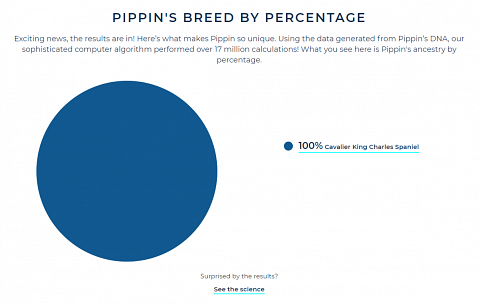
My dog’s breed percentage results.
Clicking on “See the Science”, I learned that Wisdom Panel had looked at more than 1800 genetic markers to calculate my dog’s breed percentage. There was also an informational video showing how his DNA was extracted and analysed.
There was some breed information about Cavalier King Charles Spaniels – in case this breed result was surprising for me – as well as height and weight ranges for the breed. There was a “Did You Know?” section, as well as a few breed attributes, like being a good family dog and being food-motivated (which sounded about right).
There was a family tree for Pippin, which I learned had been calculated using an algorithm – which is probably a lot more complicated and impressive for mixed breed dogs!
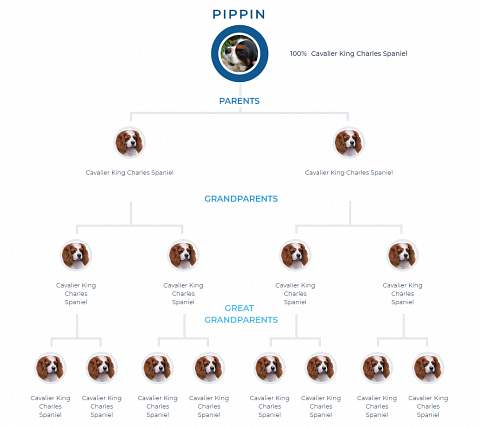
My dog’s family tree.
If your dog is mixed breed, Wisdom Panel’s algorithm will compare possible family trees and settle on whichever is most likely for your dog, depending on their genetic markers and breed percentages.
There was also a printable “Statement of Authentication” certificate, confirming that Pippin was 100% Cavalier.

My dog’s breed authentication certificate.
Results Section: Purebred Analysis
Since I’d stated my dog is a purebred, there were three additional tests to confirm his breed. One was a single breed comparison, showing how genetically similar he is to other Cavaliers in the Wisdom Panel database. A cluster graph showed that he was pretty similar to most! (Shown below.)
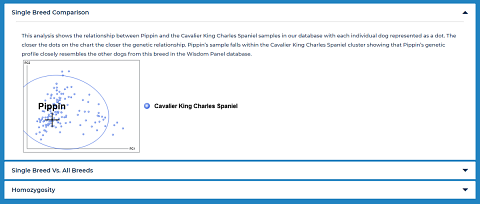
My dog’s breed comparison results.
The second test compared my dog both to other Cavaliers and to the other breeds in the database, and found that he was most like the other Cavaliers, excluding the likelihood of him being more similar to, say, a Cocker Spaniel.
The third test was a homozygosity test, which measured how many of my dog’s genetic markers were identical, since they’d been passed down from both the mother and the father (which I gathered was due to inbreeding…). My dog’s homozygosity score was around 73%, the average score for Cavalier’s being around 65% to 75%. This seemed worryingly high, and made me glad there are more regulations now to prevent inbreeding!
Results Section: Health Information
There wasn’t much to the health results section, which was a little underwhelming. I found that my dog was clear of a mutation in the MDR1 gene that causes sensitivity to multiple drugs.
Wisdom Panel had also calculated an ideal weight range for my dog, between 6 – 12kg. My dog is pretty big for a Cavalier, and is around 12kg.

My dog’s ideal weight range.
My dog gets weighed regularly at the vet, and so I know he is within his ideal range, though he was at the top of his genetically-calculated one. In the extra information, I read that factors such as the nutrition of his mother during pregnancy and nursing and his early nutrition could also affect adult weight, which in my dog’s case is also affected by the fact of him being a (still pretty small) giant in the Cavalier community.
There was also a guide for telling whether your dog is a healthy weight by the visibility of their ribs, spine and hip bones, and how defined their waist is.
Summary
I was pleased with Wisdom Panel’s analysis of my dog’s breed, and felt confident in their findings. If you’re wondering which breeds make up your dog’s ancestry, then I thoroughly recommend this test. If you’re unsure whether or not your dog is purebred, the additional tests they offer (included at no extra charge) provide a thorough means of confirmation. As the test currently is, the health information is not very comprehensive. However, if you are testing a mixed breed dog, then it is unlikely your dog will have any serious genetic health risks, in which case the breed and drug sensitivity information alone is great value for money.
At a Glance
Summary
The Wisdom Panel 2.0 Breed Identification test was an excellent way to find out about Winnie’s breed and ancestry. The presentation of the report was excellent and the descriptions really helped to match up Winnie’s characteristics to the different breeds in her DNA.
I would have liked a bit more information about the scientific evidence supporting the test, especially since the company emphasises its research expertise on the website.
Overall though, this test was great value for money and gave me a surprising and detailed insight into Winnie’s genetic background. I’d highly recommend it to anyone that wants to find out more about their dog, particularly those with a rescue.
Full Review
Mars Veterinary are the organisation that developed the Wisdom Panel 2.0 analysis. As well as this test, they produce a range of pet products including the ‘Cesar’ and ‘Sheba’ dog and cat foods.
More importantly, they’ve been researching and analysing canine DNA for over a decade, to develop a database of patterns associated with a range of specific breeds. As this is the largest database of its kind in the world, including over 185 breeds, I was excited to trying it out on Winnie, my rescue dog.
Product expectations
Reading the product description on the Wisdom Panel website, I was provided with comprehensive information about the test. As well as stating the size of the database, there was a list of the breeds included in the analysis. I was even able to search for ones that I was particularly interested in finding out about, to see if they could be detected in the analysis.
The description outlined the four main aspects that would feature in the results: ‘Breed Analysis’, ‘Ancestry’, ‘Predicted Weight’ and ‘Behavioural Characteristics’. I also learned that they would analyse more than 1800 markers to determine these results.
I was slightly surprised to see that the test could be used on purebred dogs as well as those that are a mix of different breeds. For those with purebreds, two additional features would be included, to compare the dog to others of the same breed. I had been worried that the report might be quite boring if Winnie turned out to be a purebred, so was pleased to see these additional features. I was impressed that Wisdom Panel had taken this into consideration and offered something to make the service valuable to all dog owners.
There was also a lot of information included about what to expect at each stage of the process. As well as details of what would be included in the kit, the instructions and several sample reports were available to read and download.
Ordering Experience
Ordering the Wisdom Panel test was slightly unusual, as when I clicked on the ‘Buy Now’ button, I was taken to an Amazon page to purchase the test.
For me this was great, as I have an Amazon Prime account and so I was able to receive the kit the next day for no charge. Even if I hadn’t had Prime, the fact that the test was sold through Amazon meant that I’d have been able to ‘Click & Collect’ the kit or have it delivered in 3-5 days for free. However, I imagine that that ordering through Amazon might be a bit off putting for those that don’t already have an account.
Results section
Once I’d received my kit, I took Winnie’s sample with no problem and sent it back. I received an email notifying me once the samples had reached the lab and within three weeks I received another with my results.
The email included Winnie’s result in a 10MB PDF file as well as a link to an online video explaining a bit more about the science behind the testing. I thought the video was an excellent way to display this information and it provided a good introduction to the results.
Looking at the results themselves, I was immediately informed that Winnie (to my surprise) is a Greyhound, Saluki, Bedlington Terrier, Whippet Cross (shown below). I was surprised as I’d previously assumed that she was a purebred Whippet.
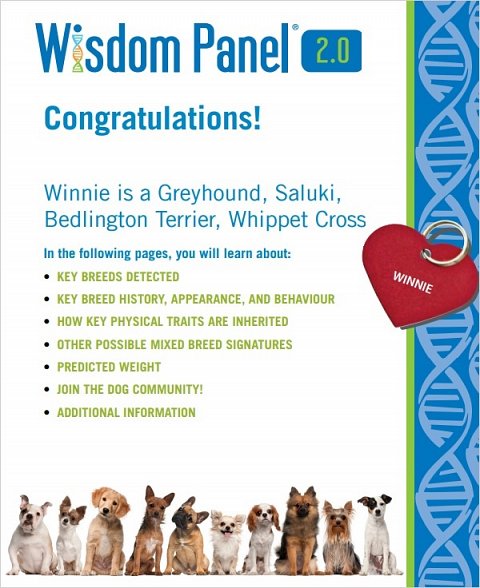
The front page of the report, which provided Winnie’s breed mix.
This page was personalised to include Winnie’s name in her breed breakdown and in a little heart shaped collar tag, which was a lovely touch. This page also outlined the seven sections of the report: ‘Key Breeds Detected’, ‘Key Breed History Appearance and Behaviour’, ‘How Key Physical Traits are Inherited’, ‘Other Possible Mixed Breed Signatures’, ‘Predicted Weight’, ‘Join the Community’ and ‘Additional Information’.
Results section: Key Breeds Detected
The first, and for me the most valuable, part of the report was the section that detailed the key breeds detected in Winnie’s DNA, displayed as a family tree (shown below).
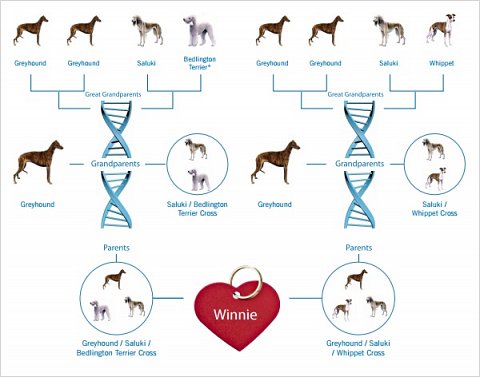
Winnie’s Family Tree.
Although I had already been informed of the mix of breeds that make up Winnie’s DNA, it was really interesting to see which of her ancestors are likely to have been which of the different breeds. I found out that she is likely the offspring of one Greyhound/Saluki/Bedlington Terrier Cross and one Greyhound/Saluki/Whippet Cross - so a real mix! One thing that would have helped me to understand her mix more clearly would have been to have been the approximate percentages that each breed contributed to her DNA, as I assumed she was more greyhound than anything else, but couldn’t work out quite how much.
The family tree was bought alive by pictures of the different breeds and these helped to show how each had contributed to Winnie’s appearance. The way it was laid out made it easy to understand and also perfect for printing to show friends and relatives – many couldn’t believe how many breeds she’s made up of!
I had initially been worried that three generations of Winnie’s ancestry wouldn’t provide much of a family tree, but this went back to her great grandparents and provided plenty of detail about her ancestry.
The only real downside of this section was the lack of detail about how these conclusions had been reached. For example, the explanation about how Wisdom Panel had worked out the family tree stated that they had analysis had included “over 7 million calculations using 11 different models”, which, although providing impressive numbers, didn’t actually explain anything about the methods used.
Results section: Key Breed History, Appearance and Behaviour
The next part of the report went into more detail about the history of the breeds that contributed to Winnie’s DNA, as well as distinctive features of each breed’s appearance and behaviour (shown below).
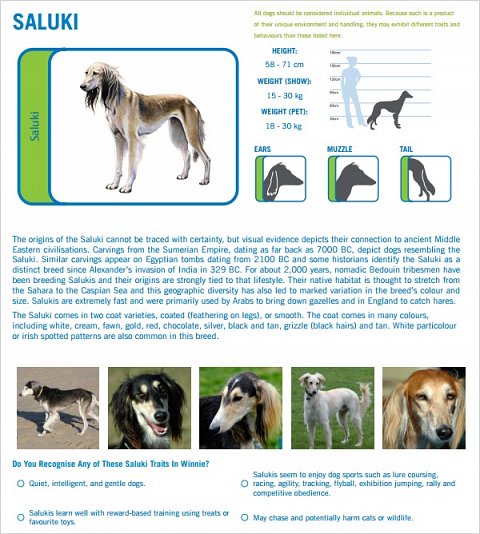
The Saluki breed profile.
Each breed had its own profile, with the same general layout. This included details about their average height, weight, ear, muzzle and tail shape, colour variations and general temperament. I was impressed by the fact that they had managed to include so much information, but in a way that was concise and therefore not overwhelming.
I was most interested to read about the Saluki breed, as I had never heard of it before. There was a picture of a generic Saluki as well as several smaller photographs of different variations. I found out that they were a very ancient breed, having been depicted in carvings from as early as the BC era!
The most significant thing I noticed was that ‘quiet’, ‘intelligent’ and ‘gentle’ were the most common words used to describe the temperaments of the breeds, which are exactly the words I would use to describe Winnie. She can have her crazy moments though, which can now be explained by her Bedlington Terrier DNA - this breed was were described as “Active, alert, intelligent yet clownish”! This confirmation this quite specific set of traits really convinced me of the value of this report, and I felt like I’d gotten a real insight into Winnie’s character that I hadn’t had before.
Results section: How Physical Traits Are Inherited
Although it was useful to have the science explained, I found that the section describing how physical traits are inherited in dogs repeated a lot of what was included in the video I had watched previously. However, I appreciate that not everyone will have chosen to watch the video and understanding the general science behind how canine inheritance works was key to fully understanding the results. This section also included an example (shown below), which helped to put the information from the video into context.
It’s a shame that there weren’t references to any published research papers in this section, as I was interested to find out more, but wasn’t quite sure where to start. I also would have liked to have been able to check sources of their information.

The example showing how physical traits are inherited.
Results Section: Join the Dog Community
The ‘Dog Community’ aspect of the Wisdom Panel service was great, though I was disappointed not to find any dogs with the exact same mix of breeds as Winnie. I should also point out that this isn’t really part of the results, as you have to go on the Wisdom Panel website to access this feature. You also don’t have to have purchased the test to view the dogs on this community webpage.
Results Section: Predicted Weight Profile and Additional Information
The predicted weight section contained a lot more text and far fewer images/diagrams than the other sections. This was the only section that was based not only on the DNA analysis, but on additional information that I’d provided (that Winnie is female and spayed). This was clearly a good combination, as Winnie, who is a healthy weight, is within the range predicted.
It was explained that a lot of factors can affect a dog’s weight, both genetic and environmental, and provided links to further information. However, when I clicked on the links, I was disappointed to find that one redirected to the ‘Royal Canin’ homepage (another company owned by Mars Incorporated) and another led to a ‘Page not found’. After a bit of exploring, I did find their ‘Knowledge Centre’, but to read the article I had to sign up to the ‘Royal Canin’ newsletter. I felt a bit let down by the poor maintenance of the links, but also the fact they’d disguised promotion of their other pet products as purely informative material.
Other additional features included how to follow Wisdom Panel on various social media platforms, question suggestions for discussing Winnie’s results with her veterinarian and finally her certificate (shown below).
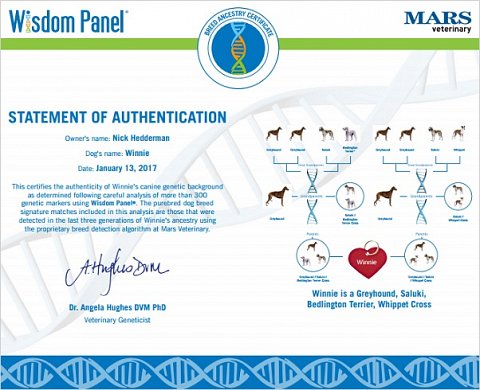
Winnie’s Breed Certificate.
I assumed that this was mainly designed for those with purebred dogs, to show that they are just that. However, I loved the addition of this feature and it made the results feel like they carried some real weight.
There were instructions about how to customise the certificate by adding a photo – another personal touch that I really appreciated.
Summary
The Wisdom Panel 2.0 Breed Identification test was an excellent way to find out about Winnie’s breed and ancestry. The presentation of the report was excellent and the descriptions really helped to match up Winnie’s characteristics to the different breeds in her DNA.
I would have liked a bit more information about the scientific evidence supporting the test, especially since the company emphasises its research expertise on the website.
Overall though, this test was great value for money and gave me a surprising and detailed insight into Winnie’s genetic background. I’d highly recommend it to anyone that wants to find out more about their dog, particularly those with a rescue.


